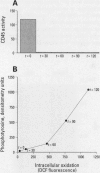Abstract
Phosphotyrosine phosphatases (PTPs) serve as important regulators of cellular signal transduction pathways. PTPs are sensitive targets of oxidative stress and may be inhibited by treatments that induce intracellular oxidation. The effects of PTP inactivation under oxidizing conditions are amplified by the redox-linked activation of key protein tyrosine kinases (PTKs), thus leading to the initiation of phosphotyrosine-signaling cascades that are no longer under normal receptor control. These ligand-independent signals result in the accumulation of protein phosphotyrosine, the generation of second messengers, the activation of downstream kinases, and the nuclear translocation of nuclear factor kappa B (NF-kappa B). In this review we consider the relative contribution of oxidative stress to the effects of PTP inhibition by vanadium-based compounds in lymphocytes. Although the inactivation of PTPs can lead to NF-kappa B mobilization in the presence of antioxidants, the other effects noted appear to require a threshold of intracellular oxidation. The combined effects of oxidative stress on signal transduction cascades reflect a synergy between the initiation of signals by PTKs and the loss of control by PTPs. This suggests a mechanism by which environmental agents that cause oxidative stress may alter the course of cellular responses through induction or enhancement of signaling cascades leading to functional changes or cell death.
Full text
PDF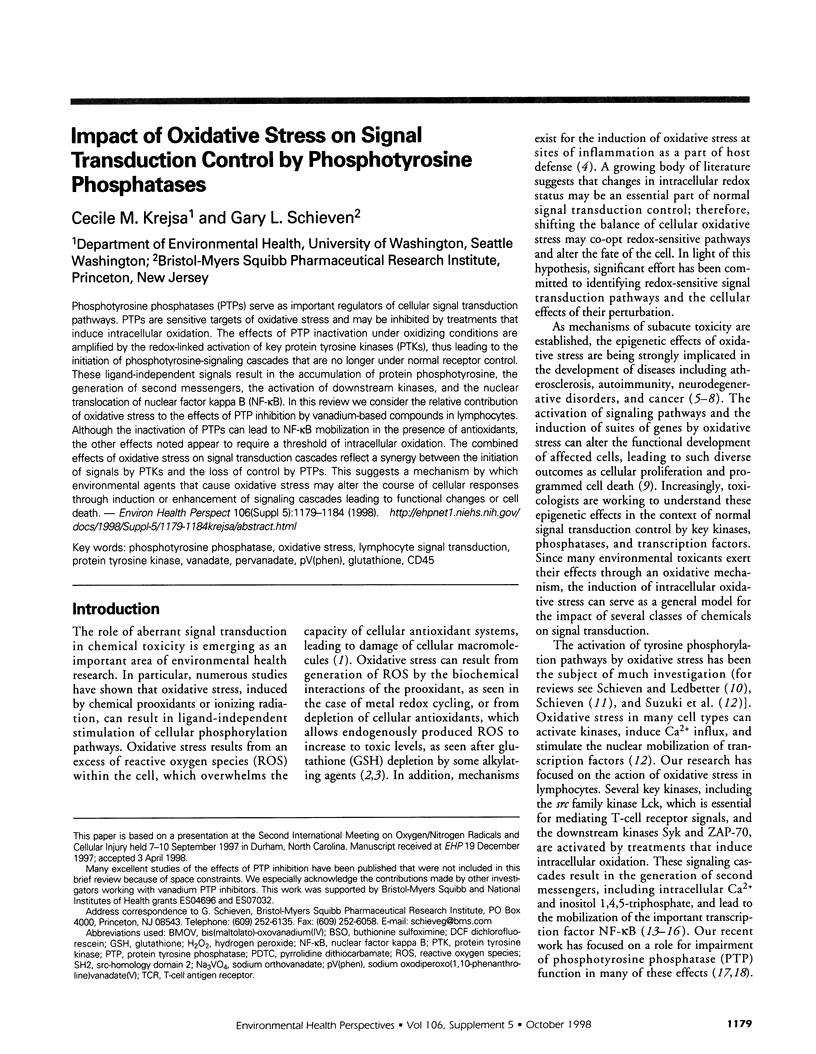
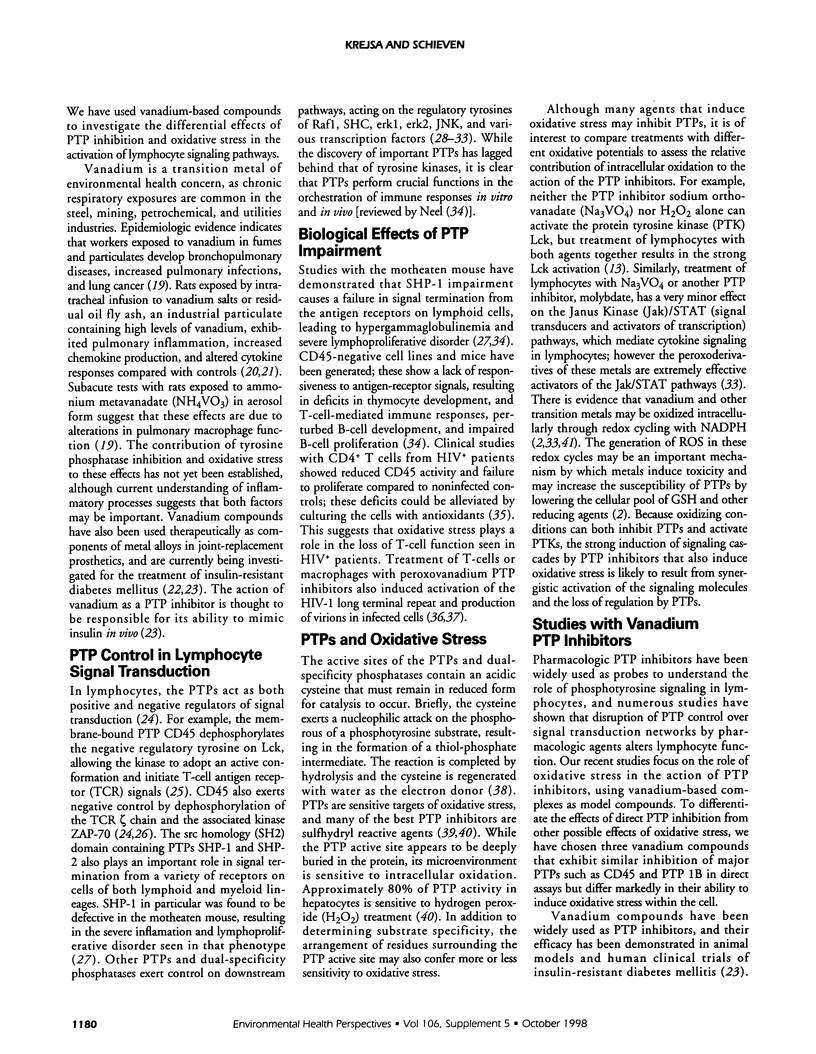
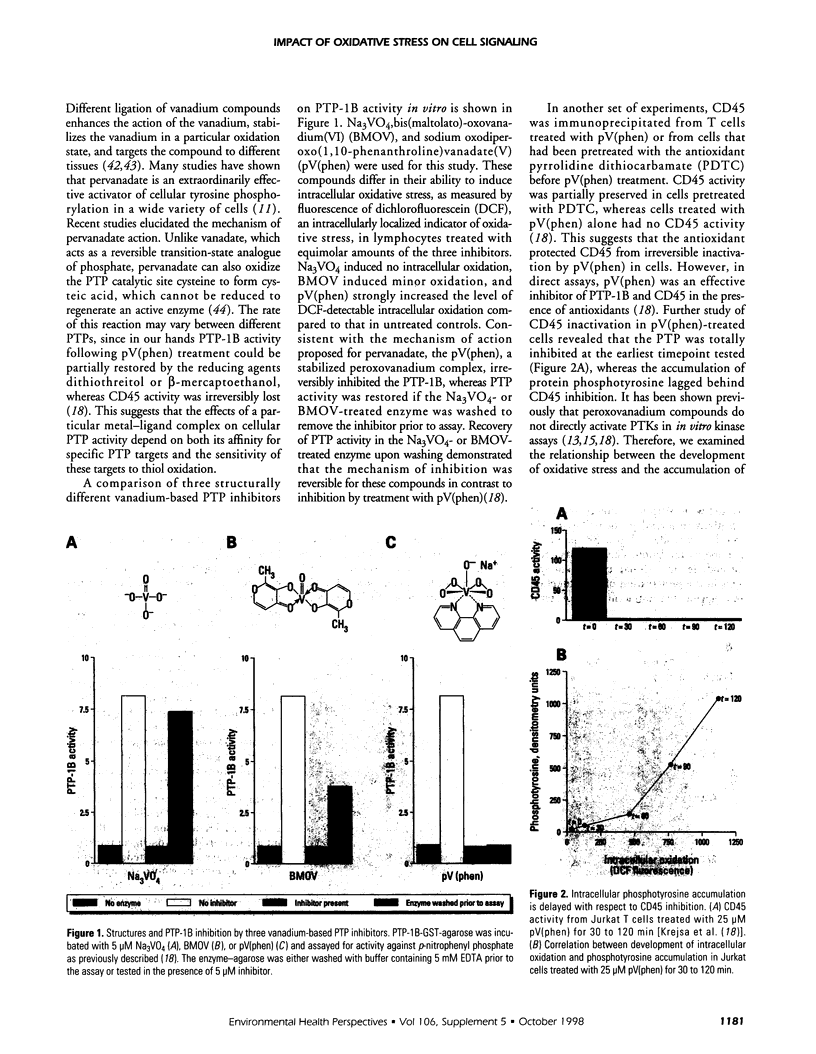
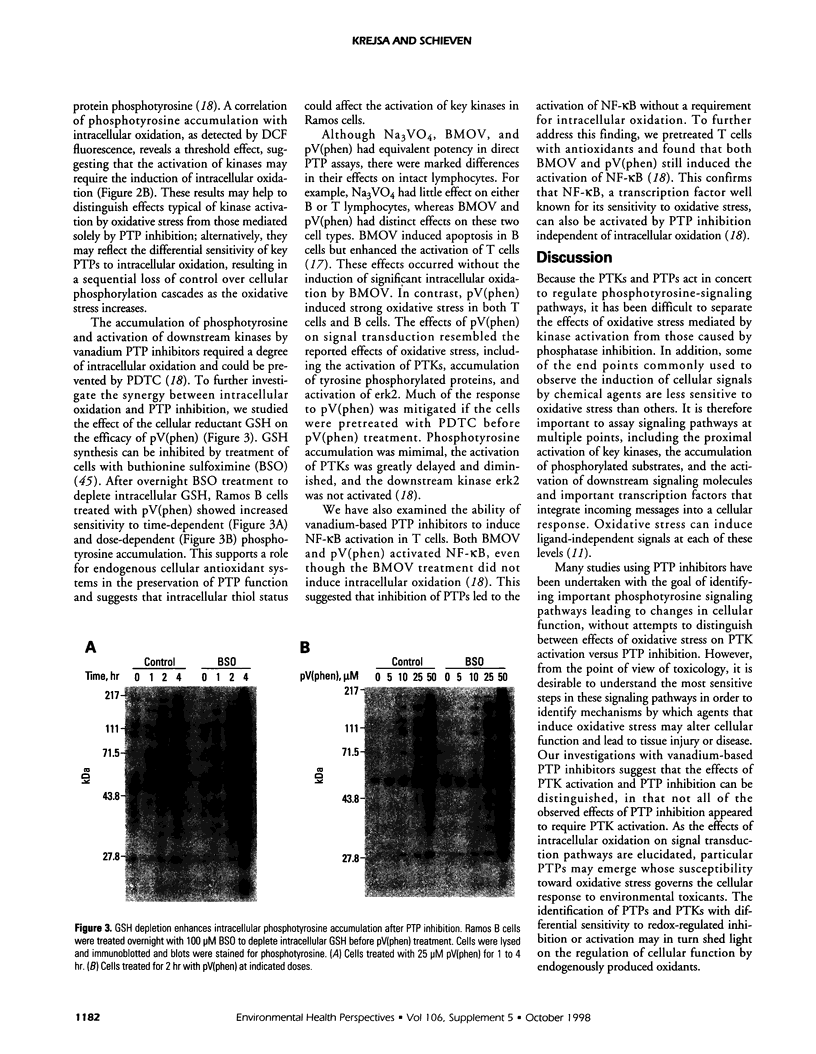
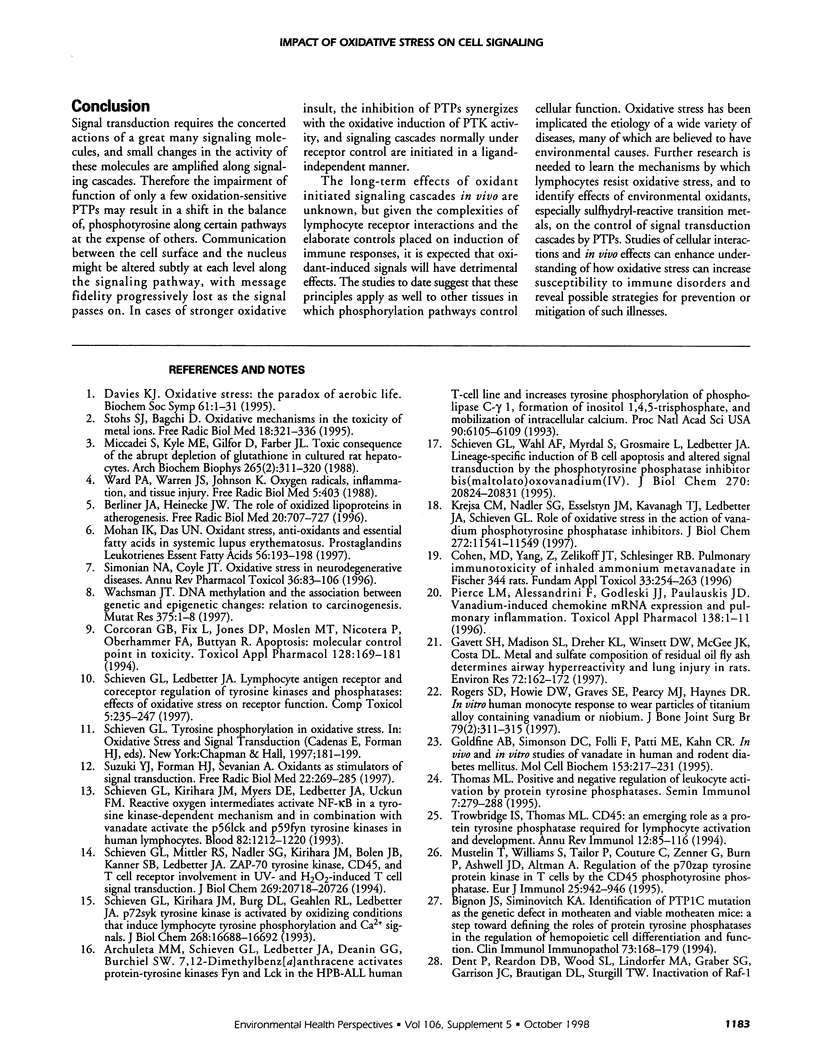
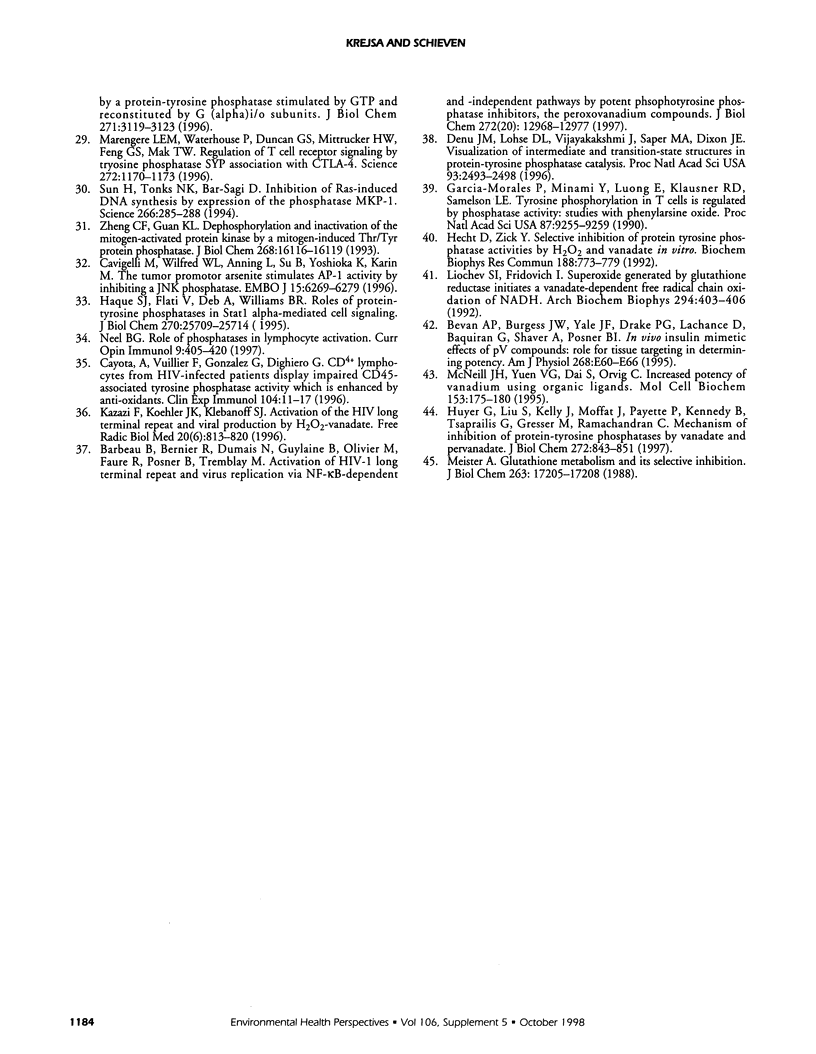
Images in this article
Selected References
These references are in PubMed. This may not be the complete list of references from this article.
- Archuleta M. M., Schieven G. L., Ledbetter J. A., Deanin G. G., Burchiel S. W. 7,12-Dimethylbenz[a]anthracene activates protein-tyrosine kinases Fyn and Lck in the HPB-ALL human T-cell line and increases tyrosine phosphorylation of phospholipase C-gamma 1, formation of inositol 1,4,5-trisphosphate, and mobilization of intracellular calcium. Proc Natl Acad Sci U S A. 1993 Jul 1;90(13):6105–6109. doi: 10.1073/pnas.90.13.6105. [DOI] [PMC free article] [PubMed] [Google Scholar]
- Barbeau B., Bernier R., Dumais N., Briand G., Olivier M., Faure R., Posner B. I., Tremblay M. Activation of HIV-1 long terminal repeat transcription and virus replication via NF-kappaB-dependent and -independent pathways by potent phosphotyrosine phosphatase inhibitors, the peroxovanadium compounds. J Biol Chem. 1997 May 16;272(20):12968–12977. doi: 10.1074/jbc.272.20.12968. [DOI] [PubMed] [Google Scholar]
- Berliner J. A., Heinecke J. W. The role of oxidized lipoproteins in atherogenesis. Free Radic Biol Med. 1996;20(5):707–727. doi: 10.1016/0891-5849(95)02173-6. [DOI] [PubMed] [Google Scholar]
- Bevan A. P., Burgess J. W., Yale J. F., Drake P. G., Lachance D., Baquiran G., Shaver A., Posner B. I. In vivo insulin mimetic effects of pV compounds: role for tissue targeting in determining potency. Am J Physiol. 1995 Jan;268(1 Pt 1):E60–E66. doi: 10.1152/ajpendo.1995.268.1.E60. [DOI] [PubMed] [Google Scholar]
- Bignon J. S., Siminovitch K. A. Identification of PTP1C mutation as the genetic defect in motheaten and viable motheaten mice: a step toward defining the roles of protein tyrosine phosphatases in the regulation of hemopoietic cell differentiation and function. Clin Immunol Immunopathol. 1994 Nov;73(2):168–179. doi: 10.1006/clin.1994.1185. [DOI] [PubMed] [Google Scholar]
- Cavigelli M., Li W. W., Lin A., Su B., Yoshioka K., Karin M. The tumor promoter arsenite stimulates AP-1 activity by inhibiting a JNK phosphatase. EMBO J. 1996 Nov 15;15(22):6269–6279. [PMC free article] [PubMed] [Google Scholar]
- Cayota A., Vuillier F., Gonzalez G., Dighiero G. CD4+ lymphocytes from HIV-infected patients display impaired CD45-associated tyrosine phosphatase activity which is enhanced by anti-oxidants. Clin Exp Immunol. 1996 Apr;104(1):11–17. doi: 10.1046/j.1365-2249.1996.d01-652.x. [DOI] [PMC free article] [PubMed] [Google Scholar]
- Cohen M. D., Yang Z., Zelikoff J. T., Schlesinger R. B. Pulmonary immunotoxicity of inhaled ammonium metavanadate in Fisher 344 rats. Fundam Appl Toxicol. 1996 Oct;33(2):254–263. doi: 10.1006/faat.1996.0163. [DOI] [PubMed] [Google Scholar]
- Corcoran G. B., Fix L., Jones D. P., Moslen M. T., Nicotera P., Oberhammer F. A., Buttyan R. Apoptosis: molecular control point in toxicity. Toxicol Appl Pharmacol. 1994 Oct;128(2):169–181. doi: 10.1006/taap.1994.1195. [DOI] [PubMed] [Google Scholar]
- Davies K. J. Oxidative stress: the paradox of aerobic life. Biochem Soc Symp. 1995;61:1–31. doi: 10.1042/bss0610001. [DOI] [PubMed] [Google Scholar]
- Dent P., Reardon D. B., Wood S. L., Lindorfer M. A., Graber S. G., Garrison J. C., Brautigan D. L., Sturgill T. W. Inactivation of raf-1 by a protein-tyrosine phosphatase stimulated by GTP and reconstituted by Galphai/o subunits. J Biol Chem. 1996 Feb 9;271(6):3119–3123. doi: 10.1074/jbc.271.6.3119. [DOI] [PubMed] [Google Scholar]
- Denu J. M., Lohse D. L., Vijayalakshmi J., Saper M. A., Dixon J. E. Visualization of intermediate and transition-state structures in protein-tyrosine phosphatase catalysis. Proc Natl Acad Sci U S A. 1996 Mar 19;93(6):2493–2498. doi: 10.1073/pnas.93.6.2493. [DOI] [PMC free article] [PubMed] [Google Scholar]
- Garcia-Morales P., Minami Y., Luong E., Klausner R. D., Samelson L. E. Tyrosine phosphorylation in T cells is regulated by phosphatase activity: studies with phenylarsine oxide. Proc Natl Acad Sci U S A. 1990 Dec;87(23):9255–9259. doi: 10.1073/pnas.87.23.9255. [DOI] [PMC free article] [PubMed] [Google Scholar]
- Gavett S. H., Madison S. L., Dreher K. L., Winsett D. W., McGee J. K., Costa D. L. Metal and sulfate composition of residual oil fly ash determines airway hyperreactivity and lung injury in rats. Environ Res. 1997 Feb;72(2):162–172. doi: 10.1006/enrs.1997.3732. [DOI] [PubMed] [Google Scholar]
- Goldfine A. B., Simonson D. C., Folli F., Patti M. E., Kahn C. R. In vivo and in vitro studies of vanadate in human and rodent diabetes mellitus. Mol Cell Biochem. 1995 Dec 6;153(1-2):217–231. doi: 10.1007/BF01075941. [DOI] [PubMed] [Google Scholar]
- Haque S. J., Flati V., Deb A., Williams B. R. Roles of protein-tyrosine phosphatases in Stat1 alpha-mediated cell signaling. J Biol Chem. 1995 Oct 27;270(43):25709–25714. doi: 10.1074/jbc.270.43.25709. [DOI] [PubMed] [Google Scholar]
- Hecht D., Zick Y. Selective inhibition of protein tyrosine phosphatase activities by H2O2 and vanadate in vitro. Biochem Biophys Res Commun. 1992 Oct 30;188(2):773–779. doi: 10.1016/0006-291x(92)91123-8. [DOI] [PubMed] [Google Scholar]
- Huyer G., Liu S., Kelly J., Moffat J., Payette P., Kennedy B., Tsaprailis G., Gresser M. J., Ramachandran C. Mechanism of inhibition of protein-tyrosine phosphatases by vanadate and pervanadate. J Biol Chem. 1997 Jan 10;272(2):843–851. doi: 10.1074/jbc.272.2.843. [DOI] [PubMed] [Google Scholar]
- Kazazi F., Koehler J. K., Klebanoff S. J. Activation of the HIV long terminal repeat and viral production by H2O2-vanadate. Free Radic Biol Med. 1996;20(6):813–820. doi: 10.1016/0891-5849(95)02214-7. [DOI] [PubMed] [Google Scholar]
- Krejsa C. M., Nadler S. G., Esselstyn J. M., Kavanagh T. J., Ledbetter J. A., Schieven G. L. Role of oxidative stress in the action of vanadium phosphotyrosine phosphatase inhibitors. Redox independent activation of NF-kappaB. J Biol Chem. 1997 Apr 25;272(17):11541–11549. doi: 10.1074/jbc.272.17.11541. [DOI] [PubMed] [Google Scholar]
- Liochev S. I., Fridovich I. Superoxide generated by glutathione reductase initiates a vanadate-dependent free radical chain oxidation of NADH. Arch Biochem Biophys. 1992 May 1;294(2):403–406. doi: 10.1016/0003-9861(92)90703-y. [DOI] [PubMed] [Google Scholar]
- Marengère L. E., Waterhouse P., Duncan G. S., Mittrücker H. W., Feng G. S., Mak T. W. Regulation of T cell receptor signaling by tyrosine phosphatase SYP association with CTLA-4. Science. 1996 May 24;272(5265):1170–1173. doi: 10.1126/science.272.5265.1170. [DOI] [PubMed] [Google Scholar]
- McNeill J. H., Yuen V. G., Dai S., Orvig C. Increased potency of vanadium using organic ligands. Mol Cell Biochem. 1995 Dec 6;153(1-2):175–180. doi: 10.1007/BF01075935. [DOI] [PubMed] [Google Scholar]
- Meister A. Glutathione metabolism and its selective modification. J Biol Chem. 1988 Nov 25;263(33):17205–17208. [PubMed] [Google Scholar]
- Miccadei S., Kyle M. E., Gilfor D., Farber J. L. Toxic consequence of the abrupt depletion of glutathione in cultured rat hepatocytes. Arch Biochem Biophys. 1988 Sep;265(2):311–320. doi: 10.1016/0003-9861(88)90133-6. [DOI] [PubMed] [Google Scholar]
- Mohan I. K., Das U. N. Oxidant stress, anti-oxidants and essential fatty acids in systemic lupus erythematosus. Prostaglandins Leukot Essent Fatty Acids. 1997 Mar;56(3):193–198. doi: 10.1016/s0952-3278(97)90533-0. [DOI] [PubMed] [Google Scholar]
- Mustelin T., Williams S., Tailor P., Couture C., Zenner G., Burn P., Ashwell J. D., Altman A. Regulation of the p70zap tyrosine protein kinase in T cells by the CD45 phosphotyrosine phosphatase. Eur J Immunol. 1995 Apr;25(4):942–946. doi: 10.1002/eji.1830250413. [DOI] [PubMed] [Google Scholar]
- Neel B. G. Role of phosphatases in lymphocyte activation. Curr Opin Immunol. 1997 Jun;9(3):405–420. doi: 10.1016/s0952-7915(97)80088-x. [DOI] [PubMed] [Google Scholar]
- Pierce L. M., Alessandrini F., Godleski J. J., Paulauskis J. D. Vanadium-induced chemokine mRNA expression and pulmonary inflammation. Toxicol Appl Pharmacol. 1996 May;138(1):1–11. doi: 10.1006/taap.1996.9999. [DOI] [PubMed] [Google Scholar]
- Rogers S. D., Howie D. W., Graves S. E., Pearcy M. J., Haynes D. R. In vitro human monocyte response to wear particles of titanium alloy containing vanadium or niobium. J Bone Joint Surg Br. 1997 Mar;79(2):311–315. doi: 10.1302/0301-620x.79b2.7192. [DOI] [PubMed] [Google Scholar]
- Schieven G. L., Kirihara J. M., Burg D. L., Geahlen R. L., Ledbetter J. A. p72syk tyrosine kinase is activated by oxidizing conditions that induce lymphocyte tyrosine phosphorylation and Ca2+ signals. J Biol Chem. 1993 Aug 5;268(22):16688–16692. [PubMed] [Google Scholar]
- Schieven G. L., Kirihara J. M., Myers D. E., Ledbetter J. A., Uckun F. M. Reactive oxygen intermediates activate NF-kappa B in a tyrosine kinase-dependent mechanism and in combination with vanadate activate the p56lck and p59fyn tyrosine kinases in human lymphocytes. Blood. 1993 Aug 15;82(4):1212–1220. [PubMed] [Google Scholar]
- Schieven G. L., Mittler R. S., Nadler S. G., Kirihara J. M., Bolen J. B., Kanner S. B., Ledbetter J. A. ZAP-70 tyrosine kinase, CD45, and T cell receptor involvement in UV- and H2O2-induced T cell signal transduction. J Biol Chem. 1994 Aug 12;269(32):20718–20726. [PubMed] [Google Scholar]
- Schieven G. L., Wahl A. F., Myrdal S., Grosmaire L., Ledbetter J. A. Lineage-specific induction of B cell apoptosis and altered signal transduction by the phosphotyrosine phosphatase inhibitor bis(maltolato)oxovanadium(IV). J Biol Chem. 1995 Sep 1;270(35):20824–20831. doi: 10.1074/jbc.270.35.20824. [DOI] [PubMed] [Google Scholar]
- Simonian N. A., Coyle J. T. Oxidative stress in neurodegenerative diseases. Annu Rev Pharmacol Toxicol. 1996;36:83–106. doi: 10.1146/annurev.pa.36.040196.000503. [DOI] [PubMed] [Google Scholar]
- Stohs S. J., Bagchi D. Oxidative mechanisms in the toxicity of metal ions. Free Radic Biol Med. 1995 Feb;18(2):321–336. doi: 10.1016/0891-5849(94)00159-h. [DOI] [PubMed] [Google Scholar]
- Sun H., Tonks N. K., Bar-Sagi D. Inhibition of Ras-induced DNA synthesis by expression of the phosphatase MKP-1. Science. 1994 Oct 14;266(5183):285–288. doi: 10.1126/science.7939666. [DOI] [PubMed] [Google Scholar]
- Suzuki Y. J., Forman H. J., Sevanian A. Oxidants as stimulators of signal transduction. Free Radic Biol Med. 1997;22(1-2):269–285. doi: 10.1016/s0891-5849(96)00275-4. [DOI] [PubMed] [Google Scholar]
- Thomas M. L. Positive and negative regulation of leukocyte activation by protein tyrosine phosphatases. Semin Immunol. 1995 Aug;7(4):279–288. doi: 10.1006/smim.1995.0032. [DOI] [PubMed] [Google Scholar]
- Trowbridge I. S., Thomas M. L. CD45: an emerging role as a protein tyrosine phosphatase required for lymphocyte activation and development. Annu Rev Immunol. 1994;12:85–116. doi: 10.1146/annurev.iy.12.040194.000505. [DOI] [PubMed] [Google Scholar]
- Wachsman J. T. DNA methylation and the association between genetic and epigenetic changes: relation to carcinogenesis. Mutat Res. 1997 Apr 14;375(1):1–8. doi: 10.1016/s0027-5107(97)00003-1. [DOI] [PubMed] [Google Scholar]
- Ward P. A., Warren J. S., Johnson K. J. Oxygen radicals, inflammation, and tissue injury. Free Radic Biol Med. 1988;5(5-6):403–408. doi: 10.1016/0891-5849(88)90114-1. [DOI] [PubMed] [Google Scholar]
- Zheng C. F., Guan K. L. Dephosphorylation and inactivation of the mitogen-activated protein kinase by a mitogen-induced Thr/Tyr protein phosphatase. J Biol Chem. 1993 Aug 5;268(22):16116–16119. [PubMed] [Google Scholar]




